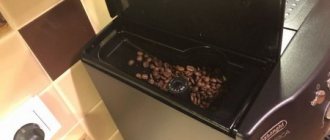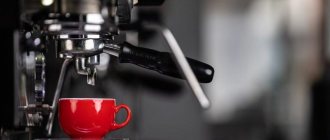All about pressure in coffee machines: technical characteristics
Coffee is a drink loved by many around the world. Its use has become traditional in business circles. It is believed that the drink invigorates, clears the mind, promotes activity, and drives away sleep. But it is also important that coffee has a special characteristic taste that many people like, as well as its excellent aroma. And even though the drink has certain contraindications (for example, it is not recommended for people with cardiovascular diseases and children), it is becoming increasingly popular.
And for this it is very important to prepare it correctly. If previously the procedure was carried out manually, now there are many useful devices for this. Manufacturers are trying to satisfy people's needs by offering more and more functional, easy-to-use, economical and attractive options. One of these is a coffee machine. The equipment allows you to prepare not only coffee, but also other similar drinks: macchiato, latte and others. And the steam pressure in the coffee machine plays an important role in the procedure. Let's take a closer look at this parameter, what it should be to get a quality drink, and what it affects.
A little history
To understand the issues of pressure in a coffee machine, it is worth tracing the evolutionary process, how this direction developed, how technology was improved.
What is the pressure in the coffee machine? How does this indicator affect the aroma and taste of coffee? To answer these questions, you need to understand the history of coffee.
The first device was created back in 1843. In this device, the drink was prepared using steam pressure. Since this was the first option, there were a lot of shortcomings in it. The technique was characterized by low pressure and burnt coffee.
Already at the beginning of the 20th century, the device was improved. In this case, a combination of steam and water was used. This technique revealed to us the concept of “holder” and others. The water boiled, the high pressure of the coffee machine promoted the passage of steam through the raw materials, and the drink fell into the container.
Four years later, the model was improved: a valve and a piston pump were added. The inventor of this equipment gave humanity the basics of making modern espresso. His name was Pavoni. He calculated the optimal pressure in a coffee machine - over 9 bar. And the temperature should be 86–92 degrees.
Many years after this, capsule coffee machines will be invented, which use a similar principle, but do not require lengthy procedures with coffee. But the main principle remains the same - due to high pressure, steam passes through the coffee mass, ensuring the preservation of the aromatic and taste qualities of the drink.
At the end of World War II, a coffee machine was invented that pumped out high pressure, creating a thick layer of foam that became the hallmark of espresso.
As you can see from history, steam pressure is an integral part of preparing a tasty and aromatic coffee drink. And as a result, already in the 60s, the first coffee machine with a pump was created. In this case, the pressure is achieved by operating an electric pump. No physical effort is required from the operator.
Now we will answer the question of what maximum pressure can be achieved in coffee machines. And the answer is simple. The developers achieved an important goal - the ability to regulate the pressure level in a wide range - from 3.5 to 20 bar. Therefore, 15 bar, which many consider to be the maximum for coffee machines, is high, but not maximum.
As a result, it can be argued that the user's understanding of how important the level of pressure in technology is allows him to understand the quality of the solutions offered on the market.
A little bit of history
Coffee machines are the pinnacle of coffee making. Unlike a regular coffee maker, a coffee machine is a fully automated technique that can both grind coffee beans and brew them, preparing an amazing drink. The first such apparatus, which used steam power, was manufactured in 1843. It was a very large machine that was capable of brewing a large number of cups of coffee. But such a device was not only huge and inconvenient, but also explosive.
Only 50 years later a coffee machine appeared that could supply steam under pressure and brew ground coffee. In 1901, a patent was registered to improve the steam coffee machine. It was already distinguished by its compact size and quite practical use.
A coffee machine is an automated device that saves time, making it especially suitable for busy people.
Options
What is the maximum pressure in a modern coffee machine? 15 bar is far from the “ceiling”. For example, Cremesso capsule devices are characterized by a pressure of 19 bar. This level can provide foam of sufficient density, while maintaining the taste and aroma of the drink. This ensures a temperature of 92 degrees. Under the influence of such conditions, the bottom of the capsule bends, which is pierced by special spikes, due to which the liquid enters the cup.
Separately, it is necessary to say why the pressure of 15 bar is so often remembered. This level is set for preparing classic espresso. The water heats up to 92 degrees. This ensures a high speed of preparation of the drink - about 30 s.
So, here are the parameters to ensure the conditions for preparing classic espresso:
- the temperature of the liquid in the boiler should be 87–95 degrees;
- water pressure in the horn – 8–10 bar;
- pump pressure – from 15 bar.
Main causes of failures and their elimination
First, you need to make sure that the resulting drink has not heated up in the machine and has not cooled down in the cup. Many engineers advise warming up the mug a little before placing it under the stream (for example, holding it under hot water or over steam). This will ensure that the coffee does not cool down due to the low temperature of the liquid in the machine.
If the problem is not in the dishes, then the cause can be sought in incorrectly set settings (in the selected mode). Using the instructions in the instructions, you need to go to the menu and set the temperature parameter to the maximum value.
In a coffee machine, cold coffee is often produced due to an unheated brewer. This happens when the device has not had time to warm up after being turned on, and its owner has already decided to make coffee. In such a situation, you should just wait.
But there are failures that require the attention of specialists. These include:
- problems with heating elements (heating elements, etc.);
- vapor block malfunction;
- control module malfunction;
- oxidation of contacts;
- problems with the controller.
In the first case, you will immediately understand that there is a problem. The process of preparing the drink will suddenly become long, and its taste will lose its richness. It will begin to seem that instead of coffee in the mug there is ordinary water (sometimes with a coffee smell). Extraneous noise will also appear. A common cause is scale that needs to be cleaned from internal elements. It is this that leads to defects in the operation of the heating element , as a result of which it will need to be replaced.
The second problem will be especially acute for lovers of drinks with a high milk content. It simply won’t whip, and the temperature will also begin to drop. If necessary, the technician replaces the entire unit or its faulty parts. There are also cases when, to eliminate a defect, it is enough to clean the device from dirt.
Independent unqualified intervention in the design in the event of a malfunction of the control module can lead to the device becoming completely unusable. The engineer will configure the board and, if necessary, replace it with a new one.
Oxidation of contacts is manifested by spontaneous shutdowns of the device. When the degree of oxidation is severe enough, your machine simply stops working. This requires knowledge in the field of electronics, as stripping of wires will be required.
The controller is an element through which energy is transmitted to all parts of the coffee maker. In particular, he gives it to Teng. Therefore, its malfunction leads to the fact that the coffee machine prepares warm coffee and completely fails. Manufacturers do not recommend replacing it yourself.
If your unit does not heat the water, then contact the engineers of the A-Iceberg Unified Service Service for help. They will help you fix the problem and also provide a guarantee on the work done and the parts replaced.
Pump and boiler pressure
The pressure sensor in the boiler indicates overheating of the equipment or the onset of operating mode. In the latter case, the sensor moves the arrow to the green zone. During operation, the pressure level may decrease, then you need to wait until the indicators stabilize so that the equipment returns to operating parameters. With modern equipment this happens very quickly.
The pump pressure sensor in the coffee machine indicates deviations in the parameter from the norm.
If the pressure does not match
At low pressure, the coffee turns out to be of lower quality, and foam does not form. Therefore, it is important to monitor this parameter. Although modern coffee machines do this on their own, only signaling to the user if something goes wrong.
Therefore, you should try to initially purchase a coffee machine from a well-known manufacturer, which will simplify the task of making coffee, and make the procedure pleasant and effective. The coffee will definitely turn out tasty, aromatic, and healthy. And for this, it is advisable to immediately decide what drinks will be prepared. This will help you choose either a simple model or a device with advanced capabilities that allow you to prepare several types of coffee drinks at once.
Source
Operating pressure of the coffee machine
On some devices you can find a reading from 15 to 20 bar. This is the operating pressure of the pump. At the outlet, that is, in the horn, it is 8 - 9 bar. This is the optimal indicator at which you get delicious espresso with foam. If you imagine that the water will flow under a pressure of 15 - 20 bar, then at this pressure in the coffee machine, espresso simply will not be prepared, since the liquid will simply fly out through the horn without having time to extract all the substances from the ground grain.
The opposite process: a pressure of 5 - 6 bar will also not prepare the drink, because it is too small to “squeeze” essential oils out of the beans in 30 seconds, even with very hot water. Therefore, the answer to what pressure or how many bar should be in a coffee machine is one: 8 - 9. All manufacturers of good machines try to increase the pressure to 9 bar at the outlet of the horn. Everything else is distributed among other nodes in the unit.
Video: General coffee machine settings
Technical indicators of the coffee maker that affect the taste
The material of the horn body is of particular importance. If the part is made of steel, then when boiling water gets into it, the coffee tablet warms up well. Consequently, the grains release all the aromatic substances. In a plastic case, the drink turns out watery due to insufficient heating.
The boiler also creates pressure, only in this case steam for frothing milk. If the pressure in the coffee machine boiler rises, a safety valve opens and releases it. The temperature of the water in the coffee machine boiler depends on the amount of coolant inside.
In professional models it reaches 120 degrees. The container is usually filled to 70% so that excess pressure does not damage the assembly. The liquid in the boiler is not used to brew coffee - it serves as a heat source to heat the water that will be used to make espresso.
The amount of liquid in the boiler is an important indicator for the stable operation of the coffee maker. The larger it is, the better it holds the temperature and the better the brewing liquid heats up.
Dispensing tubes, of which there may be several depending on the performance of the unit, are the nodes through which boiling water flows to the holder. The more dispensing units, the more portions you can prepare at the same time. The pressure in these units corresponds to the required 9 bar.
Why is steam needed in a coffee machine - to supply it to an automatic cappuccino maker or a steam wand for manually frothing milk. The temperature of the steam in a coffee machine is usually the same as the temperature of water, so when using the wand you need to be careful not to direct the stream onto areas of the body.
Adjusting the pressure in the coffee machine
A sensor installed inside the unit prevents overheating of the unit if the equipment operates in continuous mode. When you turn on the machine, you can determine from its indicators that the unit is ready for operation.
In automatic models, the sensor can alert users to problems by displaying an error message. In manual and semi-automatic coffee makers, you need to independently monitor the sensor indicators.
There are 2 pressure gauges in the coffee machine - for the boiler and pump. After using steam to froth milk, the pressure in the boiler may drop below the permissible level. Monitoring the arrow readings, you need to wait until the machine restores functionality, that is, it heats the water to the desired temperature and the steam creates the required pressure.
The pump pressure gauge shows the pressure in the espresso brew group. In the operating mode of a good coffee maker it is 8 - 9 bar. When the equipment is disabled – 0.
Review of automatic coffee machines
One of the main characteristics of household appliances is its cost. Our online store offers you to buy an inexpensive automatic bean coffee machine for your home or office at a low price.
For a budget purchase, you can consider a device for two cups from PHILIPS. This is a good option for home use. Mid-priced machines will withstand the intensity of use in a small work team.
The more respectable BOSCH (BOSH) for 2.4 liters and DELONGHI ECAM (DELONGHI ICAM) for 2 liters of water are already professional automatic coffee machines in cafes, coffee shops, and large groups.
Many housewives place the ergonomic qualities of household appliances above all else. They will appreciate the built-in automatic coffee machine presented in our catalog.
How to choose a coffee maker
Coming to the store and not knowing anything about the design of coffee makers, people are lost in the range and technical indicators. Sellers, of course, are trying to sell a product from a higher price segment, but people need a carob coffee maker for home use. So the main task will be to choose a device that meets the technical characteristics of delicious espresso:
- The pressure in the coffee machine must be at least 8 bar. Anything less will cost less, but will not work well. You cannot save on a pump if everyone in the family is a coffee lover.
- A large boiler volume is an important indicator if you need to cook many portions in a row. This will allow the device to consistently supply boiling water and steam to the cappuccino maker.
- Unit power. Affects the rate of heating of water in the boiler.
Sellers may say that the higher the pump pressure, the better. 15 bar of pressure for a coffee machine is normal, but this is the maximum potential value. The output will still be 9 bar. Buying a device based on these parameters is like buying a sports car with a potential speed of 350 km/h to drive through city traffic jams.
The best carob coffee makers will cost at least $500 in foreign currency. It is not recommended to buy cheaper units, since the drinks will be watery, without foam, and you will have to go to a bar to drink normal coffee and spend additional money on it.
Criteria for selecting bean coffee machines
In your home or office, you want to have the best-rated bean coffee machine with a good automatic cappuccino maker. All presented models have high ratings and excellent reviews. When choosing a bean coffee machine, pay attention to the technical characteristics of each model (and among them choose the model that suits you):
- volume of tanks for water and grains;
- power consumption;
- number of grinding levels;
- adjusting the strength and portion of water;
- types of drinks;
- the ability to prepare two cups at the same time;
- convenient display.
In our online store you can buy inexpensive automatic coffee machines for your home or office of various characteristics at low prices.
Geyser coffee maker
If we compare the pressure in a geyser coffee maker relative to a coffee machine, it will be about 4 times lower. This is 2 - 2.5 bar. Pressure is created using the generated steam, which squeezes water up the tube onto the coffee tablet.
Thanks to such a simple device, you can brew a good drink, although without foam, since the water pressure is not enough to create it.
If you grind the coffee too finely and compact it too hard, the brewing process will be delayed. It is possible that the emergency valve for releasing steam, which is located on the side of each such coffee maker, will be activated.
The advantage of a geyser device is that it is almost eternal due to its simplicity. In Chinese analogues, the rubber ring may become leaky and will have to be replaced to prevent steam from escaping from the inside.
Did you like the article? Share with your friends:
Functions and components of a coffee machine
The task of the coffee machine is to grind the poured beans and pass hot water steam through them. The person presses a button and receives the finished drink ordered in accordance with the program. Models differ in their set of functions. They heat the glasses, whip the cream, grind the grains coarsely and finely.
To perform all the functions, the inventors equipped the coffee machine with:
- containers for water, coffee beans and waste products;
- dispensers;
- devices for grinding and brewing;
- tubes, pump (pump).
How all this interacts with each other is described in the article “Design and principle of operation of a coffee machine.”
What a simple coffee maker does is clear from the name. She's just brewing. The coffee is poured already ground. Boiling water is poured inside the device and a single flavor recipe is obtained. And no pressure affects him.
The bar determines the strength of the water
But coffee makers are constantly being improved. Models with a semi-automatic operating principle have appeared. Special mechanisms measure the required volume of powder and water and warm the cups before serving, just like in coffee machines.
Capsules and the drip brewing method already allow you to experiment with water pressure. In pressure coffee makers, boiling water is pressed through a layer of ground coffee.
The unit of measurement for water pressure was 1 bar. It does not belong to any measurement system, but people all over the world have recognized it. Physicists consider 1 atmosphere to be an equivalent parameter, but they try not to use it.
History of coffee makers
Optimal indicator
The pressure level in a coffee machine and coffee maker affects the formation of foam, enrichment of aroma, creation of taste, and cooling of the drink.
A pressure gauge reading of 9 bar guarantees good espresso coffee. It serves as the basis for all other coffee recipes. But it took years of work by inventors to arrive at this figure.
The first Italian mechanics
An Italian inventor named Moriondo created a device with a water vapor pressure of 1.5 bar. Patented in 1885, the coffee maker existed for 7 years. Luigi Bezzera improved it and achieved an indicator of 2 bars. But it was not possible to keep it constant. Whatever grain he ground during the cooking process, the taste in each cup was different in strength.
Signor Pavoni came up with the idea of installing a control valve. This helped keep the pressure at the same level. But it was not possible to increase the steam force. The figure did not exceed 2 bar.
Down with manual labor
The optimal pressure of 9 bar was achieved by 1940, when an additional lever was used to pump water. With this invention, Achil Gadzhia's establishment went down in history. The name appeared - coffee machine. The barista served the drinks with thin foam. It has become an indicator of proper espresso.
The manual piston was replaced with an automatic one after 20 years. Italian Carlo Valente used an electric pump. Now, creating the desired steam did not require any effort, and the taste of the coffee drink became better due to the precise brewing time.
Electronics got involved
The massive use of electronics at the end of the 20th century in all areas was also reflected in coffee machines. Inventors create multifunctional devices.
The desired button allows you to select the option of preparing a hot or cold drink. The menu depends on the device model.
Troubleshooting Methods
Repair of a coffee machine will depend on which link in the chain of its elements has failed. The most common causes of low blood pressure are:
- Pump failure. The pump is the mechanism that provides the necessary pressure in the system. Often it breaks due to breakage or clogging of the spring with scale. In the second case, cleaning the coffee machine from lime salts will help. The decalcification process starts with a solution or tablet recommended by the manufacturer. If the result is positive, the pump’s operation will be restored in a short time. The final breakdown of the pump is manifested by a complete cessation of coffee supply. To fix this breakdown, it is better to contact a service center - for example, Tabera Service (website: https://tabera.ru/remont-kofemashin/).
- Filter clogged. The problem is solved by thoroughly washing the filter under running water or, if disposable filters are used, by replacing it.
- Airlock. The breakdown is eliminated by running hot water through the cappuccino maker.
- Incorrect pressure sensor adjustment. Following the instructions, you need to set the device to operating pressure (over 1.5 bar).
- Coffee grind too fine. Small particles form a continuous mass that blocks the water supply. Changing the grind settings can improve the situation.
Another cause of malfunction may be a clogged O-ring or the formation of a thick layer of scale on the tubes and hoses inside the device. The sealing ring is replaced with a similar new one, scale is removed using special solutions.
Thus, the first action of the user at home is to remove scale and coffee oils. If this method does not help, the device is carefully inspected and its settings are checked. If a part is obviously broken or the cause of the problem is unclear, you should seek the help of specialists.
About pressure in different types
Drip brewing
If we take into account the stages of development of coffee makers, then the operating principle of the drip variety remains at the level of the 19th century. The water boils in the boiler, drops of condensate flow through the brewing unit into the prepared cup.
Only Americano is prepared in drip devices. For cooking, use medium grind grains
Universal percolators
In percolators, steam from boiling water travels up a tube, onto the coffee powder, and then onto the filter. Previously, to circulate water, the vessel was heated with coal, now - with electric heating elements.
The finished drink flows into a container and is poured into cups. Pressure 1.5 bar, water temperature 100 degrees.
The percolator has one container for water and the finished drink. This means it is bitter due to constant brewing. The versatility of the device lies in the ability to make a regular kettle out of it. To do this, you need to remove the percolation system.
Moke - geyser installation for brewing coffee
In this device, the liquid is heated on a gas burner and boils at the bottom of the device. Boiled water (100 degrees) rises and immediately passes through the filter funnel with coffee. Steam pressure 1.3 - 1.5 bar.
The finished brewed product ends up at the top of the installation. It pours into cups through the spout.
Now let's talk about what the grind size affects. To prevent excess substances from getting into the finished product, it is important to use a medium grind or a little finer for this brewing method.
Options for espresso
To make espresso you need to buy a steam or pump coffee maker.
In steam water, it boils in 2 minutes, turns into steam and enters the horn filter under a pressure of 5 bar. The liquid temperature is 100 degrees, which is a minus. Boiling water “pulls out” the bitterness from the grains.
The pump applies a pressure of 7 bar to a compacted coffee tablet. Both types of coffee makers create milk foam when brewing cappuccino. There is a special steam pipe for this.
Coffee machines work similarly. The pressure is not raised to 15 bar, since the standard for espresso is 9 bar.
Carob varieties
Carob coffee machines include semi-automatic and automatic coffee machines. This is a common type of espresso coffee maker. The grains in the required quantity are placed in the horn, which is why the design got its name. Otherwise the horn is called a holder.
In pump-action carob machines, the water reaches a temperature of a maximum of 95 degrees. Using a pump that creates a pressure of 8-10 bar, the liquid is pushed into the horn. In steam devices, the pressure ranges from 4 to 5 bar, and the water boils.
To preserve the taste and aroma of the drink, it is preferable to take a pump-action carob model.
Conclusions and tips for choosing coffee equipment
For those who value time
Let's summarize how much bar should be in the coffee maker for normal operation. The figure depends on what we want to get as a result. For a classic espresso with foam, you need a technique that creates a pressure of 9 bar.
Carob pump, capsule with pump and combined devices are suitable. Under the Krups and Bosh Tassimo brands, manufacturers produce espresso coffee makers with a full cycle and automation. We recommend them to those who work a lot, are constantly busy and do not like to spend a lot of time in the kitchen.
For large volumes
In new generation coffee machines, pressure can reach from 3 to 20 bar. Such devices include multifunctional products from the Swiss company Cremesso, which work with a pump.
You can track the result on the pressure gauge. But no one is using full power. For quick cooking, 15 bar is enough. The water temperature reaches 92 degrees. A cup of coffee is prepared in 30 seconds.
This speed is needed when servicing a large number of clients, guests, and employees. The unit is suitable for offices, cafes and large families. Pay attention to the Jura and Melitta brands. If you are looking for a machine for your home, read the article “Coffee machine or coffee maker: which is better for the home.”
No rush in a small company
For simple brewing, a low pressure of 2-4 bar or a pressure-free device is sufficient. They are used by people who are not in a hurry, enjoy the process and do not expect many guests in the house.
- percolators;
- carob steam coffee makers;
- pods with low pressure;
- drip and geyser devices;
- electric turks.
Useful tips for choosing
If you decide to buy a coffee machine, then it is better to buy one that is easier to use. Therefore, if you want to drink natural high-quality espresso at home or at work, it is better to use an automatic coffee machine, because:
- This coffee machine is very easy to use - you only need to press one button and the machine will work independently;
- quickly prepare aromatic espresso with foam - in just 25 seconds and a cup of coffee on the table.
- It cleans itself by storing used coffee in a special container.
For those who drink exclusively espresso, you can purchase an espresso coffee maker. This machine brews one or two cups of coffee at a time. This coffee machine uses ground coffee. Although the best choice would be an automatic espresso machine, which can also grind coffee beans and brew coffee immediately, and also pour the finished drink into the cup itself. In such coffee machines, the coffee preparation process is fully automated. Many automatic coffee machines have a feature that pre-soaks the coffee before brewing.
How to adjust pressure
Signs of a fall
If a drink comes out of the machine without foam or aroma, and the taste resembles an ordinary “chatterbox”, it is worth checking the readings on the pressure gauge.
If the finished drink comes out in a weak stream or does not come out at all, this also indicates a drop in pressure in the coffee machines.
Possible reasons
The pressure gauge readings may drop due to pump failure. This is the main mechanism affecting blood pressure. It works stably for 1-2 years. Once the warranty expires, it becomes unreliable.
Stopping the flow of liquid from the unit indicates an air lock.
The filter may become clogged if low-quality grains or capsules are regularly used for cooking. Often coffee particles clog the micro-holes due to the grinding being too fine. Do not use over-roasted coffee beans.
Main reasons
A thin or weak stream of drink indicates a decrease in pressure in the system. This can happen for two reasons: the first is a manufacturing defect, the second is a violation of the rules for operating the device.
A factory defect may look like this:
- incorrect assembly of the device;
- the use of low-quality materials and parts, leading to their premature wear;
- damage to the device during its delivery to the store.
It is also possible that the device may be damaged during transportation from the store to the place of use.
The second group of reasons is more extensive. It includes:
- lack of timely preventive examinations and regular maintenance;
- incorrect parameter settings that do not meet the requirements of the instructions;
- the use of low-quality coffee beans (old, overcooked, hard, containing foreign impurities - pieces of wood, small pebbles, etc.);
- irregular cleaning, which often provokes rapid failure of the heating elements;
- using the coffee machine at low temperatures (creates a risk of defrosting the drainage system and causing problems with the hydraulic system);
- device overload.
Voltage changes in the power supply network, forced shutdown of the coffee machine and sudden power outages can also contribute to device breakdown.











